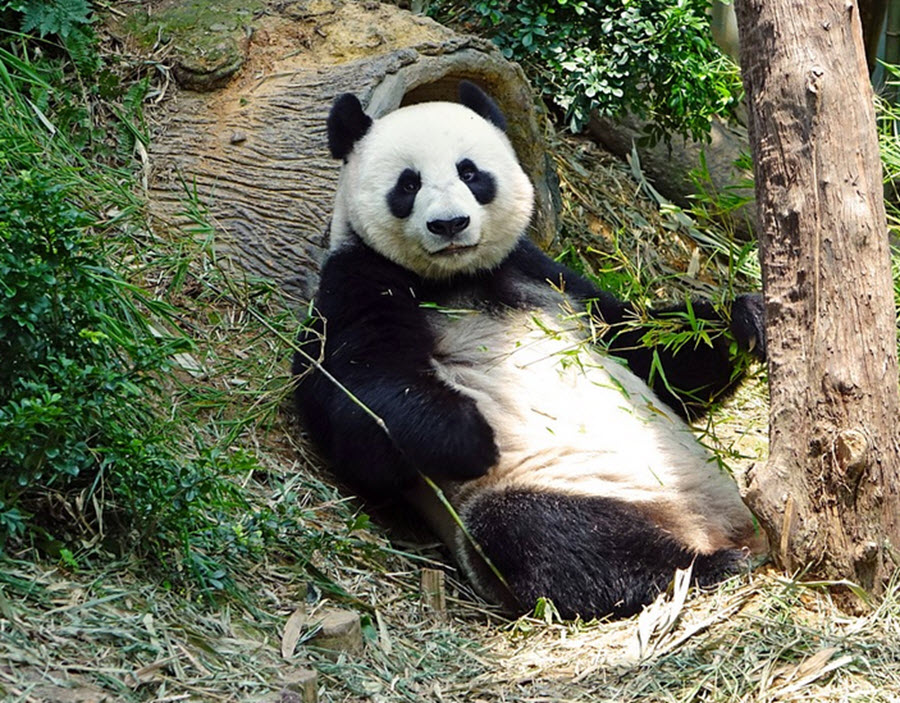Contents
The classification of the Giant panda has been the subject of much debate, and this species has variously been classified as a bear or a raccoon. Right now, it is placed in the family Ursidae – the bear family – because molecular studies have shown that it hails from the same ancestor as the other bears.

Even though it is now placed in the order Carnivora, the Giant panda is a folivore who chiefly eats bamboo shoots and leaves. In the wild, Giant pandas have also been observed occasionally eating birds, rodents and various carrion. They also sometimes eat tubers and other grasses than bamboo.
The giant panda´s paw has five fingers and a modified sesamoid bone. This modified sesamoid bone is used as if it were a thumb, and it helps the panda hold on to bamboo.
The Giant Panda used to be classified as Endangered by the IUCN, but in 2016 the species was moved to the category Volnurable to reflect an improved situation for the species in the wild.
Scientific classification
| Kingdom: | Animalia |
| Phylum: | Chordata |
| Class: | Mammalia |
| Order: | Carnivora |
| Family: | Ursidae |
| Genus: | Ailuropoda |
| Species: | A. melanoleuca |
There are two subspecies of A. melanoleuca and they differ from each other when it comes to colour patterns and cranial measurements. A majority of today´s Giant pandas belong to the nominate subspecies A. m. melanoleuca and display the well-known black-and-white fur. These pandas chiefly live in Suchuan. The subspecies A. m. qinlingensis lives in Shaanxi´s Quinling Mountains and are therefore known as Quinling pandas. Instead of being black-and-white they are light brown and white. Also, their skulls are smaller and their molars bigger.
How many Giant pandas live in the wild?
Wild population estimates vary for the Giant panda. In 2015, the conservation site Mongabay stated that the wild Giant panda population consisted of 1,864 individuals.
Where?
The remaining wild Giant pandas are found in a few mountain ranges in central China. A majority of the individuals live in Sichuan, but some are instead located in nearby Shaanxi or Gansu.
Giant pandas used to live in lowland areas as well, but human activities – including farming and deforestation – have driven them away, and the remaining wild populations are found up in the mountains.

Size
Giant pandas grow to be around 120-190 cm long and stand 60-90 cm at the shoulder.
Males weigh up to 160 kg, while females stay in the 70 kg – 125 kg span.
A Giant panda tail is 10-15 cm long. This is the second-longest tail in the bear family; only the Sloth bear has a longer tail.
Lifespan
The Giant panda typically lives around 20 years in the wild, and longer that this in captivity.
The oldest known Giant panda was Jia Jia, a captive female who lived from 1978 to 2016.
The Sichuan Giant Panda Sanctuaries
The Sichuan Giant Panda Sanctuaries consist of several nature reserves and scenic parks in China´s Sichuan province. In total, they cover 9,245 square kilometres in the Qionglai and Jiajin mountains, and over 30% of the world´s Giant pandas live here.
These reserves and parks also provide protection and suitable habitat for many other species, including Red pandas, Snow leopards and Clouded leopards. Over 5,000 different plant species grow here, including a lot of different orchids, bamboos, rhododendrons and magnolias.
Nature Reserves & Scenic Parks
- Wolong Nature Reserve (Chinese: 卧龙自然保护区)
- Fengtongzhai Nature Reserve (Chinese: 蜂桶寨自然保护区)
- Mt. Siguniang Nature Reserve (Chinese: 四姑娘山自然保护区)
- Laba River Nature Reserve (Chinese: 喇叭河自然保护区)
- Anzihe Nature Reserve (Chinese: 鞍子河自然保护区)
- Heishui River Nature Reserve (Chinese: 黑水河自然保护区)
- Jintang-Kongyu Nature Reserve (Chinese: 金汤—孔玉自然保护区)
- Caopo Nature Reserve (Chinese: 草坡自然保护区)
- Mt. Qingcheng-Dujiangyan Scenic Park (Chinese: 青城山—都江堰风景名胜区)
- Mt. Tiantai Scenic Park (Chinese: 天台山风景名胜区)
- Mt. Siguniang Scenic Park (Chinese: 四姑娘山风景名胜区)
- Xiling Snow Mountain Scenic Park (Chinese: 西岭雪山风景名胜区)
- Mt. Jiguan-Jiulonggou Scenic Park (Chinese: 鸡冠山—九龙沟风景名胜区)
- Mt. Jiajin Scenic Park (Chinese: 夹金山风景名胜区)
- Miyaluo Scenic Park (Chinese: 米亚罗风景名胜区)
- Mt. Lingzhen-Mt. Daxue Scenic Park (Chinese: 灵鹫山—大雪峰风景名胜区)
- Mt. Erlang Scenic Park (Chinese: 二郎山风景名胜区)
